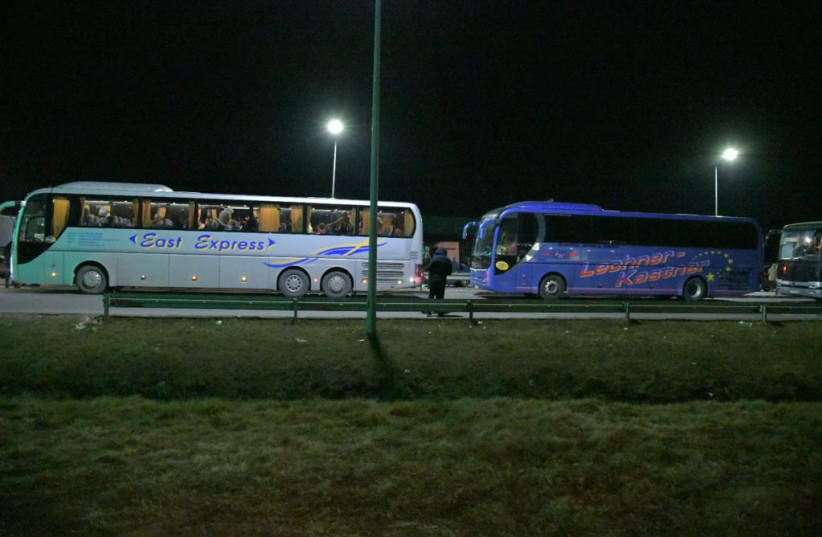Vast majority of Russian and Ukrainian Jews expected to immigrate in mass ‘exodus’ – study
An in-depth study conducted by the Institute for Jewish Policy Research (JPR) has shed light on the recent migration trends among European Jews, providing valuable insights into the political realities and experiences of Jewish communities across the continent.
The report, titled “Jewish migration today: What it may mean for Europe,” analyzes data from 15 European countries, representing approximately 94% of the Jewish population in Europe. Dr. Daniel Staetsky, Director of JPR’s European Demography Unit, authored the report.
Most Ukrainian Jews are expected to leave the country in the next 7 years, if they haven’t already, as well as more than half of Russian Jews, according to the report.
Examining migration patterns over the last century, the report reveals that no European Jewish population has witnessed a mass exodus on the scale seen during peak migration periods, such as the 1930s in Germany, the 1960s in North Africa, and the 1990s in the Former Soviet Union. Those events saw 50% to 75% of national Jewish populations migrate within a decade. In contrast, recent levels of Jewish migration from Europe indicate a different trend.
Of particular note is the situation in Russia and Ukraine, where 2022 marked a turning point. If current migration rates persist for the next seven years, it is projected that 80% to 90% of Ukraine’s 2021 Jewish population and 50% to 60% of Russia’s 2021 Jewish population will have emigrated. While France, Belgium, Italy, and Spain experienced substantial increases in Jewish emigration during the early 2010s, these numbers have since declined, although not to pre-surge levels. Despite these higher migration rates, the report does not indicate a significant Jewish ‘exodus’ from these countries.
 Buses carrying 150 Jews from Lviv in Ukraine, March 3, 2022. (credit: SHLOMI AMSALEM)
Buses carrying 150 Jews from Lviv in Ukraine, March 3, 2022. (credit: SHLOMI AMSALEM)The United Kingdom, Germany, Sweden, the Netherlands, Austria, and Denmark have generally experienced stable or declining Jewish emigration since the mid-1980s. Sweden, Denmark, and the Netherlands have observed a decline in Jewish migration over the period under examination, with migration eventually settling at a new, lower level.
Dr. Jonathan Boyd, JPR’s Executive Director, emphasized the importance of understanding migration patterns for European Jewish demography. Accurate assessments of Jewish migration into and out of Europe are essential for effective community planning. The findings from this report will inform community planning efforts across the continent, while also providing valuable insights into the economic and security landscape for Europe’s Jewish communities. Additionally, the report sheds light on the well-being of Jews in Ukraine and Russia within the context of the current war.
In a tumultuous turn of events, the year 2022 unleashed an unprecedented wave of upheaval for Russian and Ukrainian Jews. The tides of migration surged to unimaginable heights, dwarfing the feeble numbers of the preceding year, as five times the usual throng flocked to Israel. Astonishingly, the exodus continued unabated into the early throes of 2023, with migrant numbers soaring to similarly dizzying heights.
A threshold marking an ongoing exodus
Should this relentless tide persist for the next seven years, matching the staggering levels witnessed in 2022 and early 2023, an ominous threshold will be crossed—a threshold marking an ongoing and inexorable exodus. At that fateful juncture, a staggering 80% to 90% of Ukraine’s Jewish population will have bid their farewells, leaving behind mere remnants of a once-thriving community. Russia, too, will bear the weight of this cataclysmic upheaval, with 50% to 60% of its Jewish population vanishing into the shadows (figures rounded for ease of comprehension).
By stark contrast, if the flight of French Jews was to mirror its current trajectory over the next seven years, France would suffer only a meager 2% to 5% erosion of its Jewish populace—a paltry fraction compared to the catastrophic losses experienced elsewhere. The other bastions of Western Europe, along with Hungary, would be mere spectators to the specter of mass migration, their Jewish populations remaining at a considerable remove from any critical exodus that threatened to engulf their brethren.





Comments are closed.